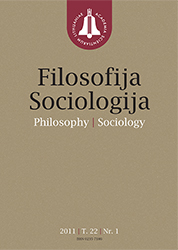
ISSN 0235-7186
ISSN 2424-4546 (online)
|
2007 m. Nr. 4
 Thinking about religious space
Anelė VOSYLIŪTĖ
The paper examines some features of religious space, its relation with religious phenomenon and social processes; it is stressed that the meeting of people with the meanings of sacred space reveals the significance of religious authority, its close relationship with the social order, confidence. In the post-socialist period all remember the negative consequences of the exclusion of this authority in the Soviet time; in contemporary society the usefulness of authority as a general analytical concept is related with such categories as social stability and socialisation.
The author analyses the relation between believers and space; such aspects as usage of sacred places, the level of trust in them, the significance and meanings of sacred space for people’s life. The background of this study is such methodological principles as the strong relation among existential experience and notion (Dilthey 1993), the trust in the subject competence, the M. Maffesoli approach. In the paper the narratives of different places are represented. The being and walking by men and women in the holy space show the level of their identity with religious values. The author uses the concept of M. Eliade that spaces differ; there can be important sacred places and other sites without such meanings. The landscape of every old nation is saturated with representation of sacredness, there are centres of religious practice on local and national scale, and the landscapes are saturated with places, routes to the sacred laces. The relation with oneself extends the meaning of place, includes religious, aesthetic, moral and transcendental aspects, it helps in the formation of solidarity ties. In modern Lithuania many churches were renovated, small chapels are constructed in hospitals and prisons; the State and the Church are seeking to give back to communities the places desecrated in the Soviet period. In cellars of old churches the funeral rooms were constructed or renovated. The author analyses the charity sites near the churches (which help to develop confidence in society, the cultivation of democracy and good activity), the meanings of pilgrimage and cemeteries. Keywords: sacred space, symbolic centre, religious feasts, Church’s functions, meanings of cemeteries
|
Numeriai:
2017 - T.28 Nr.1, Nr.2, Nr.3, Nr.42016 - T.27 Nr.1, Nr.2, Nr.3, Nr.42015 - T.26 Nr.1, Nr.2, Nr.3, Nr.42014 - T.25 Nr.1, Nr.2, Nr.3, Nr.42013 - T.24 Nr.1, Nr.2, Nr.3, Nr.42012 - T.23 Nr.1, Nr.2, Nr.3, Nr.42011 - T.22 Nr.1, Nr.2, Nr.3, Nr.42010 - T.21 Nr.1, Nr.2, Nr.3, Nr.42009 - T.20 Nr.1, Nr.2, Nr.3, Nr.42008 - T.19 Nr.1, Nr.2, Nr.3, Nr.42007 - T.18 Nr.1, Nr.2, Nr.3, Nr.42006 Nr.1, Nr.2, Nr.3, Nr.42005 Nr.1, Nr.2, Nr.3, Nr.42004 Nr.1, Nr.2, Nr.3, Nr.42003 Nr.1, Nr.2, Nr.3, Nr.42002 Nr.1, Nr.2, Nr.3, Nr.42001 Nr.1, Nr.2, Nr.3, Nr.4 |
